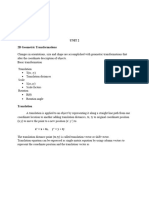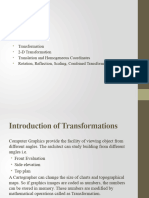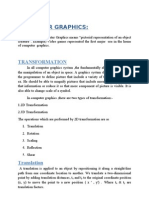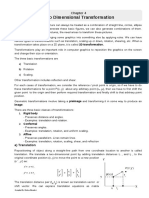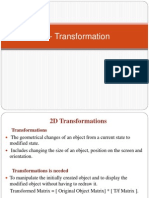Chapter 3
Chapter 3
Uploaded by
bekemaCopyright:
Available Formats
Chapter 3
Chapter 3
Uploaded by
bekemaOriginal Description:
Original Title
Copyright
Available Formats
Share this document
Did you find this document useful?
Is this content inappropriate?
Copyright:
Available Formats
Chapter 3
Chapter 3
Uploaded by
bekemaCopyright:
Available Formats
1|Page
Chapter 3: 2D Transformations
Introduction
The term Transformation is generally referred to as converting a graphic into another graphic by
applying some rules or algorithms. Sometimes an image or picture can be a combination of lines,
rectangle, circle, and triangle. If we draw the basic and combination of pictures, then there
should be a need to transform these images. Now we can perform the following actions to
transform the images-
We can change the position of an image.
We can increase or decrease the size of an image.
We can change the angle of the image.
By using the above actions, we will find a new image; this process is called Transformation. We
can use some algorithms to produce new pictures.
The object transformation includes two important points-
Geometric Transformation: When we are moving the picture, and the background is
fixed, then it is a Geometric Transformation.
Coordinate Transformation: When we are moving the background, and the picture is
fixed, then it is Coordinate Transformation.
Types of Transformation
CPU College Chapter 3 Computer Graphics
2|Page
There are two basic kinds of Translation.
1.Two-Dimensional(2D) Transformation:
“When we translate, rotate, and scale object in the two-dimensional plane, then it is called
a Two-Dimensional Transformation.” A two-dimensional plane consists of the x and y-axis.
The Two-Dimensional Transformation includes-
2D Translation: “Translation is a mechanism used to move the object from one position
to another position on the screen.”
2D Rotation: “Rotation is a process used to rotate the object from origin to a particular
angle.”
2D Scaling: “Scaling is a process or technique used to resize the object in two-
dimensional plane.”
2D Reflection: “Reflection is a mechanism or process in which we can rotate the object
at the angle of 180°”.
2D Shearing: “Shearing is a process that is used to perform slanting on the object.” It is
also called “Skewing.”
2.Three-Dimensional Transformation:
“When we translate, rotate, and scale object in the three-dimensional plane then, it is
called Three-Dimensional(3D) Transformation”. A three-dimensional plane consists of x, y,
and z-axis. The Three-Dimensional Transformation includes-
3D Translation: “Translation is a mechanism used to move the object from one position
to another position on the three-dimensional plane.”
3D Rotation: “Rotation is a process used to rotate the object from origin to a particular
angle in three-dimensional plane.”
3D Scaling: “Scaling is a process or technique used to resize the object in three-
dimensional plane”.
3D Reflection: “Reflection is a mechanism or process in which we can rotate the object
at the angle of 180° in three-dimensional plane.”
3D Shearing: “Shearing is a process that is used to perform slanting on the object.” It is
also called “Skewing”. It also includes z-axis.
CPU College Chapter 3 Computer Graphics
3|Page
1. 2D Translation
It is the straight-line movement of an object from one position to another is called
Translation. Here the object is positioned from one coordinate location to another.
Translation of point:
To translate a point from coordinate position (x, y) to another (x 1 y1), we add
algebraically the translation distances Tx and Ty to original coordinate.
x1=x+Tx
y1=y+Ty
The translation
pair (Tx,Ty) is called as shift vector. Translation is a movement of objects without deformation.
Every position or point is translated by the same amount. When the straight line is translated,
then it will be drawn using endpoints.
For translating polygon, each vertex of the polygon is converted to a new position. Similarly,
curved objects are translated. To change the position of the circle or ellipse its center coordinates
are transformed, then the object is drawn using new coordinates.
Let P is a point with coordinates (x, y). It will be translated as (x1 y1).
Consider a point object O has to be moved from one position to another in a 2D plane.
Let-
Initial coordinates of the object O = (Xold, Yold)
New coordinates of the object O after translation = (Xnew, Ynew)
CPU College Chapter 3 Computer Graphics
4|Page
Translation vector or Shift vector = (Tx, Ty)
Given a Translation vector (Tx, Ty)-
Tx defines the distance the Xold coordinate has to be moved.
Ty defines the distance the Yold coordinate has to be moved.
This translation is achieved by adding the translation coordinates to the old coordinates of the
object as-
Xnew = Xold + Tx (This denotes translation towards X axis)
Ynew = Yold + Ty (This denotes translation towards Y axis)
In Matrix form, the above translation equations may be represented as-
The homogeneous coordinates representation of (X, Y) is (X, Y, 1).
Through this representation, all the transformations can be performed using matrix /
vector multiplications.
The above translation matrix may be represented as a 3 x 3 matrix as-
Example 1: An object is placed with respect to origin on (2,1). Now move the object away from the
origin by 2 steps in x and 3 steps in y. What would be new coordinates to the moved object.
I. The old coordinates of the object are x=2 and y =1. Translation coordinate in x direction (tx) = 2
and Translation coordinate in y direction (ty) =3. Let’s call the new coordinates as x’ and y’.
CPU College Chapter 3 Computer Graphics
5|Page
II. Since the translated object is moving away from origin, hence it is a positive translation and new
coordinates could be obtained in simple arithmetic as x’=x+tx and y’=y+ty.
III. Computer Graphics only deal with matrix calculations because all the transformation would not
be as simple as in translation. Translation transformation of a single element at (x,y) coordinate is
displayed as follows.
IV. Just substitute the values of x, y as (2,1) with tx=2 and ty=1. Multiply all the matrices to get the
result. This will give you new coordinates (x’,y’) of point (x,y).
S-5: After Multiplication we would get the new element x’=2+2 = 4 and y’=1+3=4. The new element is
also displayed in last figure.
Example 2: Giv en a square with coordinate points A(0, 3), B(3, 3), C(3, 0), D(0, 0). Apply the
translation with distance 1 towards X axis and 1 towards Y axis. Obtain the new coordinates of
the square.
Given-
Old coordinates of the square = A (0, 3), B(3, 3), C(3, 0), D(0, 0)
Translation vector = (Tx, Ty) = (1, 1)
For Coordinates A(0, 3) : Let the new coordinates of corner A = (Xnew, Ynew). Applying the translation
equations, we have-
CPU College Chapter 3 Computer Graphics
6|Page
Xnew = Xold + Tx = 0 + 1 = 1
Ynew = Yold + Ty = 3 + 1 = 4 ::Thus, New coordinates of corner A = (1, 4).
For Coordinates B(3, 3) : Let the new coordinates of corner B = (Xnew, Ynew). Applying the translation
equations, we have-
Xnew = Xold + Tx = 3 + 1 = 4
Ynew = Yold + Ty = 3 + 1 = 4 ::Thus, New coordinates of corner B = (4, 4).
For Coordinates C(3, 0): Let the new coordinates of corner C = (Xnew, Ynew). Applying the translation
equations, we have-
Xnew = Xold + Tx = 3 + 1 = 4
Ynew = Yold + Ty = 0 + 1 = 1 ::Thus, New coordinates of corner C = (4, 1).
For Coordinates D(0, 0) : Let the new coordinates of corner D = (Xnew, Ynew). Applying the translation
equations, we have-
Xnew = Xold + Tx = 0 + 1 = 1
Ynew = Yold + Ty = 0 + 1 = 1 ::Thus, New coordinates of corner D = (1, 1).
Thus, New coordinates of the square = A (1, 4), B(4, 4), C(4, 1), D(1, 1).
2. 2D Rotation
2D Rotation is a process of rotating an object with respect to an angle in a two-dimensional
plane. Consider a point object O has to be rotated from one angle to another in a 2D plane. Let-
Initial coordinates of the object O = (Xold, Yold) Initial angle of the object O with respect to origin
=Φ
The Rotation of any object depends upon the two points.
CPU College Chapter 3 Computer Graphics
7|Page
Rotation Point: It is also called the Pivot point and the Rotation Angle: It is denoted by Theta ( ).
We can rotate an object in two ways-
Clockwise: An object rotates clockwise if the value of the Rotation angle is negative (-).
Anti-Clockwise: An object rotates anti-clockwise if the value of the Rotation angle is positive
(+).
We can apply Rotation on following objects-
Straight Lines Polygon
Curved Lines Circle
For Example-
Rotation of a Point: If we want to Rotate a point A (P0, Q0) that has a Rotation angle with
distance r from origin to A` (P1, Q1) that has a Rotation angle . Then, we can rotate by
following Rotation equation-
We can represent the coordinates of point A (P0, Q0) by using standard trigonometry-
We can also define point A` (P1, Q1) in the same way-
By using equation (1) (2) (3) (4), we will get-
CPU College Chapter 3 Computer Graphics
8|Page
We can also represent the Rotation in the form of matrix-
Homogeneous Coordinates Representation: The Rotation can also be represented in the form
of 3 x 3 Rotation matrix-
Example- A line segment with the starting point (0, 0) and ending points (5, 5). Apply
30-degree rotation anticlockwise direction on the line. Find the new coordinates of the
line?
Solution- We can rotate the straight line by its endpoints with the same angle.
We have, (P0, Q0) = (0, 0)
Rotation Angle () = 30°
Let the new coordinates of line = (P1, Q
CPU College Chapter 3 Computer Graphics
9|Page
We can apply the rotation matrix, then, Thus, the new endpoint coordinates of the line are
= (P1, Q1) = (1.83, 6.83)
Problem-01: Given a line segment with starting point as (0, 0) and ending point as (4, 4). Apply
30 degree rotation anticlockwise direction on the line segment and find out the new coordinates
of the line.
Problem-02: Given a triangle with corner coordinates (0, 0), (1, 0) and (1, 1). Rotate the triangle
by 90 degree anticlockwise direction and find out the new coordinates.
3. 2D Scaling
In scaling, we can expend or compress the size of any object. We can apply scaling on the object
by multiplying the original coordinates with scaling factors. The term scaling factor is used to
define whether the size of an object is increased or decreased.
Scaling may be used to increase or reduce the size of object.
Scaling subjects the coordinate points of the original object to change.
Scaling factor determines whether the object size is to be increased or reduced.
If scaling factor > 1, then the object size is increased.
If scaling factor < 1, then the object size is reduced.
We can represent the scaling factor by ‘Sx’ for the x- axis and ‘Sy’ for the y-axis. For Example-
If we want to scale an object that has R (P0, Q0) coordinate and the new coordinates of an object
are R` (P1, Q1) then the equation will be-
P1 = P0. Sx
Q1 = Q0. Sy
CPU College Chapter 3 Computer Graphics
10 | P a g e
We can also represent Scaling in the form of Matrix-
Homogeneous Coordinates Representation: The scaling is also represented in the form of 3 x 3 matrix-
Example: A Square object with the coordinate points P (1, 4), Q (4, 4), R (4, 1), T (1,1).
Apply the scaling factor 3 on the X-axis and 4 on the Y-axis. Find out the new
coordinates of the square?
Solution: We have,
Coordinates Points for Square = P (1, 4), Q (4, 4), R (4, 1), S (1, 1)
Scaling factor along with X axis (Sx) = 3
Scaling factor along with Y axis (Sy)= 4
Applying the equation to find the new coordinates-
For Coordinate P (1, 4)- Let the new Coordinate for P = (P1, Q1)
P1 = P0. Sx = 1 x 3 = 3
Q1 = Q0. Sy = 4 x 4 = 16 :The new Coordinates = (3, 16)
For Coordinate Q (4, 4)- Let the new Coordinate for Q = (P,1 Q1)
P1 = P0. Sx = 4 x 3 = 12
Q1 = Q0. Sy = 4 x 4 = 16 :The new Coordinates = (12, 16)
For Coordinate R (4, 1)- Let the new Coordinate for R = (P1, Q1)
P1 = P0. Sx = 4 x 3 = 12
Q1 = Q0. Sy = 1 x 4 = 4 The new Coordinates = (12, 4)
For Coordinate S (1, 1)- Let the new Coordinate for S = (P1, Q1)
P1 = P0. Sx = 1 x 3 = 3
Q1 = Q0. Sy = 1 x 4 = 4 The new Coordinates = (3, 4)
CPU College Chapter 3 Computer Graphics
11 | P a g e
Thus, the new coordinates for square after scaling = P (3, 16), Q (12, 16), R (12, 4), S (3,
4).
Problem-01: Given a square object with coordinate points A(0, 3), B(3, 3), C(3, 0),
D(0, 0). Apply the scaling parameter 2 towards X axis and 3 towards Y axis and obtain
the new coordinates of the object.
4. 2D Reflection
The Reflection is a mirror image of the original object. In the Reflection process, the size of the
object does not change.
We can represent Reflection by using four ways-
A. Reflection along X-axis: In this kind of Reflection, the value of X is positive, and the value
of Y is negative. We can represent the Reflection along x-axis by following equation-
X1 = X0
Y1 = -Y0
We can also represent Reflection in the form of matrix-
Homogeneous Coordinate Representation: We can also represent the Reflection along x-axis
in the form of 3 x 3 matrix-
CPU College Chapter 3 Computer Graphics
12 | P a g e
B. Reflection along Y-axis: In this kind of Reflection, the value of X is negative, and the value
of Y is positive. We can represent the Reflection along y-axis by following equation-
X1 = -X0
Y1 = Y0
We can also represent Reflection in the form of matrix-
Homogeneous Coordinate Representation: We can also represent the Reflection along
x-axis in the form of 3 x 3 matrix-
C. Reflection perpendicular to XY plane: In this kind of Reflection, the value of both X and
Y is negative. We can represent the Reflection along y-axis by following equation-
X1 = -X0
Y1 = -Y0
CPU College Chapter 3 Computer Graphics
13 | P a g e
We can also represent Reflection in the form of matrix-
Homogeneous Coordinate Representation: We can also represent the Reflection along with x-
axis in the form of 3 x 3 matrix-
D. Reflection along with the line: In this kind of Reflection, the value of X is equal to the
value of Y. We can represent the Reflection along y-axis by following equation-
Y=X, then the points are (Y, X)
Y= -X, then the points are (-Y, -X)
We can also represent Reflection in the form of matrix-
Homogeneous Coordinate Representation: We can also represent the Reflection along with x-
axis in the form of 3 x 3 matrix-
CPU College Chapter 3 Computer Graphics
14 | P a g e
Example-01: Given a triangle with coordinate points A(3, 4), B(6, 4), C(5, 6). Apply the
reflection on the X axis and obtain the new coordinates of the object.
Given-
Old corner coordinates of the triangle = A (3, 4), B(6, 4), C(5, 6)
Reflection has to be taken on the X axis
For Coordinates A(3, 4) Let the new coordinates of corner A after reflection = (Xnew, Ynew).
Applying the reflection equations, we have-
Xnew = Xold = 3
Ynew = -Yold = -4 : Thus, New coordinates of corner A after reflection = (3, -4).
For Coordinates B(6, 4) :Let the new coordinates of corner B after reflection = (Xnew, Ynew).
Applying the reflection equations, we have-
Xnew = Xold =
6
Ynew = -Yold = -4: Thus, New coordinates of corner B after reflection = (6, -4).
For Coordinates C(5, 6) :Let the new coordinates of corner C after reflection = (Xnew, Ynew).
Applying the reflection equations, we have-
Xnew = Xold =
5
Ynew = -Yold = -6: Thus, New coordinates of corner C after reflection = (5, -6).
Thus, New coordinates of the triangle after reflection = A (3, -4), B(6, -4), C(5, -6).
CPU College Chapter 3 Computer Graphics
15 | P a g e
Problem-02: Given a triangle with coordinate points A(3, 4), B(6, 4), C(5, 6). Apply the
reflection on the Y axis and obtain the new coordinates of the object.
Given-
Oldcorner coordinates of the triangle = A (3, 4), B(6, 4), C(5, 6)
Reflection has to be taken on the Y axis
For Coordinates A(3, 4): Let the new coordinates of corner A after reflection = (Xnew, Ynew).
Applying the reflection equations, we have-
Xnew = -Xold = -3
Ynew = Yold = 4 : Thus, New coordinates of corner A after reflection = (-3, 4).
For Coordinates B(6, 4):Let the new coordinates of corner B after reflection = (Xnew, Ynew).
Applying the reflection equations, we have-
Xnew = -Xold = -6
Ynew = Yold = 4: Thus, New coordinates of corner B after reflection = (-6, 4).
For Coordinates C(5, 6): Let the new coordinates of corner C after reflection = (Xnew, Ynew).
Applying the reflection equations, we have-
Xnew = -Xold = -5
Ynew = Yold = 6 :Thus, New coordinates of corner C after reflection = (-5, 6).
Thus, New coordinates of the triangle after reflection = A (-3, 4), B(-6, 4), C(-5, 6).
CPU College Chapter 3 Computer Graphics
16 | P a g e
5. 2D Shearing
Shearing deals with changing the shape and size of the 2D object along x-axis and y-axis. It is
similar to sliding the layers in one direction to change the shape of the 2D object. It is an ideal
technique to change the shape of an existing object in a two dimensional plane.
We can denote shearing with ‘SHx’ and ‘SHy.’ These ‘SHx’ and ‘SHy’ are called “Shearing
factor.” We can perform shearing on the object in two ways-
Shearing along x-axis: In this, we can store the y coordinate and only change the x
coordinate. It is also called “Horizontal Shearing.”
We can represent Horizontal Shearing by the following equation-
X1 = X0 + SHx. Y0
Y1 = Y0
We can represent Horizontal shearing in the form of matrix-
Homogeneous Coordinate Representation: The 3 x 3 matrix for Horizontal Shearing is given
below-
CPU College Chapter 3 Computer Graphics
17 | P a g e
Shearing along y-axis: In this, we can store the x coordinate and only change the y
coordinate. It is also called “Vertical Shearing.”
We can represent Vertical Shearing by the following equation-
X1 = X0
Y1 = Y0 + SHy. X0
We can represent Vertical Shearing in the form of matrix-
Homogeneous Coordinate Representation: The 3x3 matrix for Vertical Shearing is given
below-
Example: A Triangle with (2, 2), (0, 0) and (2, 0). Apply Shearing factor 2 on X-axis and 2 on
Y-axis. Find out the new coordinates of the triangle?
CPU College Chapter 3 Computer Graphics
18 | P a g e
Solution: We have, The coordinates of triangle = P (2, 2), Q (0, 0), R (2, 0)
Shearing Factor for X-axis = 2
Shearing Factor for Y-axis = 2 Now, apply the equation to find the new coordinates.
Shearing for X-axis: For Coordinate P (2, 2)- Let the new coordinate for P = (X1, Y1)
X1 = X0 + SHx. Y0 = 2 + 2 x 2 = 6
Y1 = Y0 = 2 The New Coordinates = (6, 2)
For Coordinate Q (0, 0)- Let the new coordinate for Q = (X1, Y1)
X1 = X0 + SHx. Y0 = 0 + 2 x 0 = 0
Y1 = Y0 = 0
The New Coordinates = (0, 0) For Coordinate R (2, 0)-
Let the new coordinate for R = (X1, Y1) ,
X1 = X0 + SHx. Y0 = 2 + 2 x 0 = 2
Y1 = Y0 = 0
The New Coordinates = (2, 0) , The New coordinates of triangle for x-axis = (6, 2), (0, 0), (2, 0)
Shearing for y-axis: For Coordinate P (2, 2)-
Let the new coordinate for P = (X1, Y1)
CPU College Chapter 3 Computer Graphics
19 | P a g e
X1 = X0 = 2
Y1 = Y0 + Shy.X0 = 2 + 2 x 2 = 6
The New Coordinates = (2, 6) , For Coordinate Q (0, 0)- Let the new coordinate for Q = (X1,
Y1)
X1 = X0 = 0
Y1 = Y0 +Shy. X0 = 0 + 2 x 0 =0
The New Coordinates = (0, 0), For Coordinate R (2, 0)- Let the new coordinate for R = (X1,
Y1)
X1 = X0 = 2
Y1 = Y0 + Shy. X0 = 0 +2 x 2 = 4
The New Coordinates = (2, 4) , The New coordinates of triangle for y-axis = (2, 6), (0, 0), (2, 4)
CPU College Chapter 3 Computer Graphics
20 | P a g e
Review Exercise
1. Find the coordinates of the vertices of triangle TRI with T (2, −1), R (4,3) and I (−3, −2) if it is to
be moved 5 units to the left and 2 units up.
2. Translate the point P (4,3), 3-unit the X-Direction and 5-unit Y-Direction.
3. Rotate triangle ABC by an angle 30 degree of Anti-clockwise direction where the co-ordinates
triangle are A (0,0), B (10,2), and C (7,4). Calculate the new co-ordinate of triangle.
4. Scale the triangle with the vertices A (0,0), B (2,4) and C (4,4) to twice of its size so that point C
(4,4) remain fixed.
5. Consider a triangle ABC whose co-ordinate are A (10,20), B (30,40) and C (50,20). Perform the
following transformation. Specify the matrices that are used.
I. Translate the given triangle by 30 unit to x-direction and -2 units in y-direction.
II. Rotate the given triangle by 30 degrees.
III. Reflect the given triangle about X=Y.
IV. Scale the given triangle uniformly by 2 units.
6. Write the exact transformation matrix for each basic transformation in 2Dhomogeneous
coordinate system.
7. A polygon is identified by the following positions. Identify the new positions after the polygon is
scaled by a scaling factor of 2 at the reference point (2,2), (3,3), (4,6),(8,3)(9,6). Show your
workings.
8. We rotate a point P (2, 5) by 60° about a pivot point (1, 2). The new transformed point P’ would be:
A. (– 4, 1) C. (-1, 4)
B. (1, – 4) D. (1, 4)
CPU College Chapter 3 Computer Graphics
You might also like
- Capital One CC Application Method @LarryLarrry05Document32 pagesCapital One CC Application Method @LarryLarrry05bryanclark000075% (4)
- RITMO Basic 200 Welding Machine ManualDocument81 pagesRITMO Basic 200 Welding Machine ManualAntonio CardosoNo ratings yet
- Computer Graphics-PPT - CH3Document85 pagesComputer Graphics-PPT - CH3vap3x97No ratings yet
- Unit 5 Transformation NotesDocument33 pagesUnit 5 Transformation NotesTarun BambhaniyaNo ratings yet
- Unit IiiDocument27 pagesUnit IiiLee CangNo ratings yet
- Chapter SixDocument30 pagesChapter SixHASEN SEIDNo ratings yet
- CG Chapter 5Document61 pagesCG Chapter 5kiramelaku1No ratings yet
- 2D TransformationDocument7 pages2D Transformationn02019697mNo ratings yet
- 2D Transformation PDFDocument11 pages2D Transformation PDFbassam lateefNo ratings yet
- Important Concepts Under Computer GraphicsDocument3 pagesImportant Concepts Under Computer GraphicsRavi TejNo ratings yet
- Module 3-1Document31 pagesModule 3-1maheswaranoop08No ratings yet
- Two Dimensional TransformationsDocument10 pagesTwo Dimensional TransformationsRavi Kumar KNo ratings yet
- CG Unit 3 NotesDocument30 pagesCG Unit 3 NotesCO 268 Siddharth LadeNo ratings yet
- Chapter 4 Two Dimensional Geometric Transformation and ViewingDocument14 pagesChapter 4 Two Dimensional Geometric Transformation and ViewingErmiasNo ratings yet
- 05 TransformationDocument51 pages05 TransformationAjay GhugeNo ratings yet
- Chapter Four 4. TransformationsDocument14 pagesChapter Four 4. TransformationsmazengiyaNo ratings yet
- Unit-2 CgipDocument20 pagesUnit-2 CgipYashaswini SNo ratings yet
- 2D Transformations: 3.1 TransformationDocument29 pages2D Transformations: 3.1 TransformationRokey AhmedNo ratings yet
- 2-D Geometric TransformationsDocument20 pages2-D Geometric TransformationsSubramanian ManivelNo ratings yet
- Unit 3.1 NotesDocument15 pagesUnit 3.1 NotesTanvi ShahNo ratings yet
- Geometric TransformationDocument20 pagesGeometric TransformationDivya Khanolkar50% (2)
- CG Unit 2Document113 pagesCG Unit 2kariaharsh5No ratings yet
- 3.2d TransformationDocument94 pages3.2d TransformationPrachit YelamkarNo ratings yet
- Unit 2Document28 pagesUnit 2Rahul SaiNo ratings yet
- L4 - II Computer GraphicsDocument21 pagesL4 - II Computer GraphicsروابيNo ratings yet
- Cim 23.6Document81 pagesCim 23.6RajeshKumarNo ratings yet
- Unit-3 2D TransformationDocument55 pagesUnit-3 2D Transformationfatma taqviNo ratings yet
- Title of Assignment: Problem DefinitionDocument3 pagesTitle of Assignment: Problem DefinitionSONAL S.KNo ratings yet
- 2 D TransformationsDocument29 pages2 D TransformationsAneesh ShindeNo ratings yet
- 2D Transformations in Computer GraphicsDocument6 pages2D Transformations in Computer Graphicsrohanbithari33No ratings yet
- Animation-Lect 03 - 2D-Transformation-sDocument55 pagesAnimation-Lect 03 - 2D-Transformation-smanosha.kabbaryNo ratings yet
- 2d TransformationDocument13 pages2d TransformationBipin ThapaNo ratings yet
- CG 3Document10 pagesCG 3sefefe hunegnawNo ratings yet
- Computer GraphicsDocument14 pagesComputer GraphicsNitish SandNo ratings yet
- 2D Transformation: Prepared By-Deep Tank (160110116052) Kishan Thakur (160110116054) Harshal Dankhara (160110116064)Document17 pages2D Transformation: Prepared By-Deep Tank (160110116052) Kishan Thakur (160110116054) Harshal Dankhara (160110116064)Lak HinsuNo ratings yet
- Group B Assignment 1: Title of The AssignmentDocument10 pagesGroup B Assignment 1: Title of The Assignmentradhikadikshit9No ratings yet
- 2D Translation in Computer GraphicsDocument31 pages2D Translation in Computer GraphicsleenaNo ratings yet
- BLOCK 2 Computer Graphics IgnouDocument87 pagesBLOCK 2 Computer Graphics IgnouDanielle PerryNo ratings yet
- Chapter 4 PDFDocument24 pagesChapter 4 PDFirusha100% (1)
- CS8092 Computer Graphics and Multimedia UNIT II-Two Dimensional Graphics 2.1 Two Dimensional Geometric TransformationsDocument24 pagesCS8092 Computer Graphics and Multimedia UNIT II-Two Dimensional Graphics 2.1 Two Dimensional Geometric TransformationsShirley AndrinaNo ratings yet
- Computer Graphics Lecture - 2D and 3D TransformationsDocument39 pagesComputer Graphics Lecture - 2D and 3D TransformationsgetchewNo ratings yet
- CG Unit2Document26 pagesCG Unit2zeenat parveenNo ratings yet
- CG Chapter 5Document15 pagesCG Chapter 5rajmaisuria111No ratings yet
- To Learn Translation Transformation Performed On 2-D Graphics ObjectDocument3 pagesTo Learn Translation Transformation Performed On 2-D Graphics ObjectA 24Sakshi DubeyNo ratings yet
- Unit 3 - TransformationDocument10 pagesUnit 3 - TransformationYamanNo ratings yet
- Lec3 CGDocument5 pagesLec3 CGappari0101No ratings yet
- Computer Graphics Unit-4Document17 pagesComputer Graphics Unit-4tanishaanmol5519No ratings yet
- Unit 4 2D Transformations - CG - PUDocument18 pagesUnit 4 2D Transformations - CG - PUrupak dangiNo ratings yet
- Computer Graphics Unit-2Document23 pagesComputer Graphics Unit-2tanishaanmol5519No ratings yet
- 2-Dimension Geometric TransformationDocument18 pages2-Dimension Geometric TransformationBraj KishoreNo ratings yet
- 2 - D Transformations: X' X + TX Y' y + TyDocument7 pages2 - D Transformations: X' X + TX Y' y + TyAnonymous 4hnxnYNo ratings yet
- Ch. 4 3-D TransformationsDocument57 pagesCh. 4 3-D TransformationsAneesh ShindeNo ratings yet
- Name: Pranav G Dasgaonkar Roll No: 70 CLASS: 8 (CMPN-2) CG Experiment No: 09Document12 pagesName: Pranav G Dasgaonkar Roll No: 70 CLASS: 8 (CMPN-2) CG Experiment No: 09shubham chutkeNo ratings yet
- 22CDC12 AnswersDocument14 pages22CDC12 AnswersJEEVAANANTH KNo ratings yet
- Geometric Transformation_UNIT IIDocument71 pagesGeometric Transformation_UNIT IIdharani thaneeruNo ratings yet
- CH 3Document26 pagesCH 3henihenzz21No ratings yet
- Computer Graphics Chapter FiveDocument82 pagesComputer Graphics Chapter FivejosapzedmanNo ratings yet
- Module - 2Document129 pagesModule - 2Anand ANo ratings yet
- 2D TransformationDocument34 pages2D TransformationRajNo ratings yet
- Transformation - 2DDocument93 pagesTransformation - 2DKashika MehtaNo ratings yet
- Transformation of Axes (Geometry) Mathematics Question BankFrom EverandTransformation of Axes (Geometry) Mathematics Question BankRating: 3 out of 5 stars3/5 (1)
- Two Dimensional Computer Graphics: Exploring the Visual Realm: Two Dimensional Computer Graphics in Computer VisionFrom EverandTwo Dimensional Computer Graphics: Exploring the Visual Realm: Two Dimensional Computer Graphics in Computer VisionNo ratings yet
- Final MaterialDocument55 pagesFinal MaterialbekemaNo ratings yet
- Presentation 1Document18 pagesPresentation 1bekemaNo ratings yet
- Chapter 5Document27 pagesChapter 5bekemaNo ratings yet
- Chapter 4Document8 pagesChapter 4bekemaNo ratings yet
- Chapter 2Document22 pagesChapter 2bekemaNo ratings yet
- Chapter 6Document10 pagesChapter 6bekemaNo ratings yet
- Chapter 1Document11 pagesChapter 1bekemaNo ratings yet
- Presentation LinuxDocument12 pagesPresentation LinuxbekemaNo ratings yet
- Cloud Computing Concepts Coursera HomeworkDocument6 pagesCloud Computing Concepts Coursera Homeworkistdijaod100% (1)
- Basic Electronics (18ELN14/18ELN24) - Introduction To Sequential Circuits (Module 5)Document18 pagesBasic Electronics (18ELN14/18ELN24) - Introduction To Sequential Circuits (Module 5)Shrishail BhatNo ratings yet
- READ ME FIRST - MTS-6000 Software Upgrade InstructionsDocument1 pageREAD ME FIRST - MTS-6000 Software Upgrade InstructionsslonNo ratings yet
- ModelSim Reference Manual v10.1cDocument455 pagesModelSim Reference Manual v10.1csandy milk minNo ratings yet
- Class 10 Ai EthicsDocument13 pagesClass 10 Ai EthicsShlok BakhshiNo ratings yet
- Modbus Ethernet ManualDocument68 pagesModbus Ethernet ManualantoNo ratings yet
- Automatic OMCH Establishment (SRAN12.0 - 01)Document125 pagesAutomatic OMCH Establishment (SRAN12.0 - 01)waelq2003No ratings yet
- By Jyotsna Sharva Pallavi Neha ShwetaDocument18 pagesBy Jyotsna Sharva Pallavi Neha ShwetaJyot SnaNo ratings yet
- Lab5 - 22 2 16Document4 pagesLab5 - 22 2 16bchiplunkar77No ratings yet
- 34 Samss 319Document15 pages34 Samss 319mannem88No ratings yet
- Lesson 3 CRS SetupDocument49 pagesLesson 3 CRS Setupadnan.shahab91No ratings yet
- Owner's Manual & Safety InstructionsDocument20 pagesOwner's Manual & Safety Instructionsdgdgrizo4549No ratings yet
- Content Creation Hot Potatoes JCrossDocument3 pagesContent Creation Hot Potatoes JCrossIldikó OlaszNo ratings yet
- 12a.kruchten TheAgileMemeplex 2007Document7 pages12a.kruchten TheAgileMemeplex 2007PoojaNo ratings yet
- Block Class Action LawsuitDocument53 pagesBlock Class Action LawsuitGizmodo EditNo ratings yet
- SPAN and RSPANDocument15 pagesSPAN and RSPANHiroyo Chan0% (1)
- GC 2024 06 17Document11 pagesGC 2024 06 17Jesús M LugoNo ratings yet
- Rogers, Vanessa - Cyberbullying - Activities To Help Children and Teens To Stay Safe in A Texting, Twittering, Social Networking World PDFDocument80 pagesRogers, Vanessa - Cyberbullying - Activities To Help Children and Teens To Stay Safe in A Texting, Twittering, Social Networking World PDFCoraliaNeaguNo ratings yet
- Sistemas de Comunicación Digitales y Analógicos 7ma Edicion Leon W. Couch SolDocument107 pagesSistemas de Comunicación Digitales y Analógicos 7ma Edicion Leon W. Couch SoljahazielnedzvererNo ratings yet
- AdvancedInstallationAndConfigurationManual enDocument93 pagesAdvancedInstallationAndConfigurationManual enNKGB MagenNo ratings yet
- AZ 900 ExamDocument7 pagesAZ 900 ExamGeetu SodhiNo ratings yet
- 14AAUN Level5 Test Challenge Unit4 135592Document3 pages14AAUN Level5 Test Challenge Unit4 135592lorena vidagany nogues100% (1)
- SHS AWA - July 5-9, 2021Document13 pagesSHS AWA - July 5-9, 2021Boiztupidoh Oof D'WestNo ratings yet
- Btic18214 ArdDocument3 pagesBtic18214 ArdBrijesh B NaikNo ratings yet
- Straightforward Pre SB 230908 131056Document159 pagesStraightforward Pre SB 230908 131056nurmakhanbetdina5No ratings yet
- CS-5Document84 pagesCS-5rofoxov186No ratings yet
- Amersham Frac100 ManualDocument44 pagesAmersham Frac100 Manualroccop3No ratings yet
- BrightFunded Token Whitepaper September2023Document20 pagesBrightFunded Token Whitepaper September2023arnauperezmanent1No ratings yet























